单级离心泵设计论文
- 格式:doc
- 大小:3.39 MB
- 文档页数:47
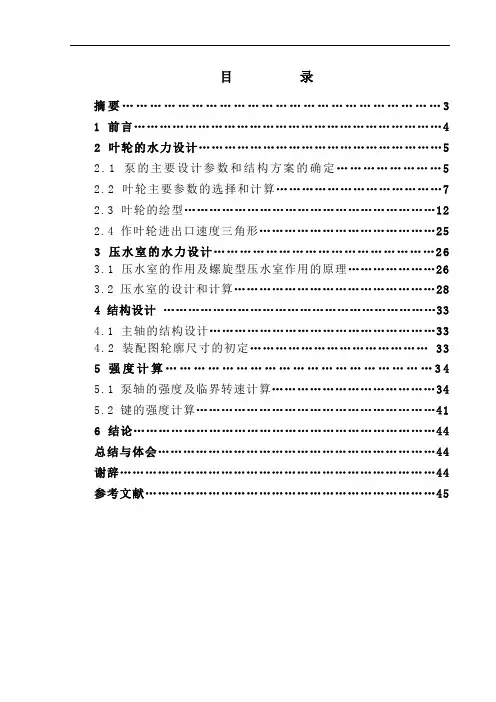
目录摘要 (3)1 前言 (4)2 叶轮的水力设计 (5)2.1泵的主要设计参数和结构方案的确定 (5)2.2 叶轮主要参数的选择和计算 (7)2.3 叶轮的绘型 (12)2.4作叶轮进出口速度三角形 (25)3压水室的水力设计 (26)3.1 压水室的作用及螺旋型压水室作用的原理 (26)3.2压水室的设计和计算 (28)4结构设计 (33)4.1 主轴的结构设计 (33)4.2 装配图轮廓尺寸的初定 (33)5强度计算 (34)5.1泵轴的强度及临界转速计算 (34)5.2键的强度计算 (41)6 结论 (44)总结与体会 (44)谢辞 (44)参考文献 (45)摘要本设计是根据给定设计参数完成单级单吸离心泵IS125—100—200的水力及结构设计。
主要包括叶轮、压水室的水力设计和泵的结构设计。
确定出叶轮的几何参数,绘制并检查叶轮轴面投影图,采用方格网保角变换法完成扭曲形叶片绘形。
利用数字积分法,根据蜗壳内速度矩守恒,确定出蜗壳八个断面参数,并进行绘形。
最后对泵进行结构设计,绘制了装配图和部分零件图,并对轴进行了强度校核计算。
关键词:离心泵;叶轮;蜗壳;水力设计;结构设计AbstractAccording to the design parameters at the given point, this paper accomplished the design of the centrifugal pump. It mainly contained the hydraulic design of the impeller, volute casing and structural of pump, structural design of the pump. Based on the resolution method of design of the pump, author obtained the geometric parameters of the impeller. Then author projected and checked the cross-section of impeller, drew the cylindrical blade using methods of grid square conformal transformation. On the basis of constant velocity moment, author calculated parameters of cross-section of volute using digital integral method. Author also drew the spiral curve and diffuser of volute casing. Finally, the structural of the pump was designed and assembly drawing component graphics were drew. In addition, this program has been checked strength of the pump shaft.【Key words】:centrifugal pumps;impeller;volute casing;hydraulic design;structural design1前言水泵是一种应用广泛的水力通用机械,在航天、航空、发电、矿山、冶金、钢铁、机械、造纸、建筑以及农业和服务业等方面都有着广泛的应用。
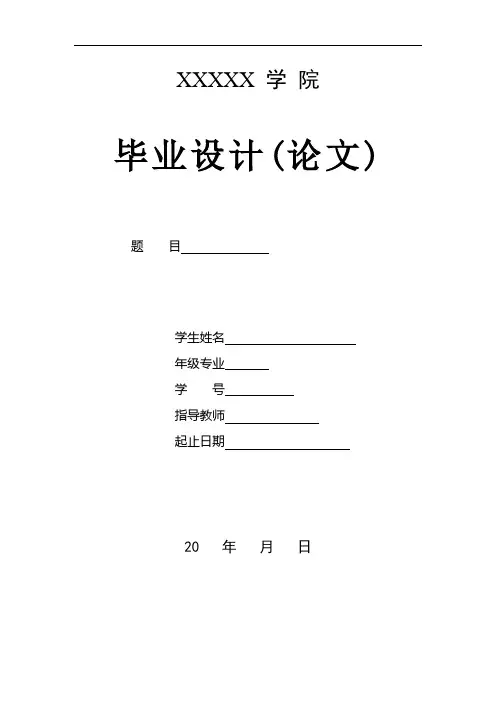
XXXXX 学院毕业设计(论文) 题目学生姓名年级专业学号指导教师起止日期20 年月日XXXXX学院毕业设计 (论文)任务书机电工程系班级()姓名学号北海职业学院学生毕业设计(论文)成绩鉴定表综述离心泵的完好标准泵与风机、压缩机是流体机械的重要组成部分,一直是制冷与空调专业人士学习的基本科目。
泵是输送液体或使液体增压的机械。
它将原动机的机械能或其他外部能量传送给液体,使液体能量增加。
泵主要用来输送液体包括水、油、酸碱液、乳化液、悬乳液和液态金属等,也可输送液体、气体混合物以及含悬浮固体物的液体。
离心泵就是根据设计高速旋转的叶轮叶片带动水转动,将水甩出,从而达到输送的目的. 离心泵有好多种.从使用上可以分为民用与工业用泵,从输送介质上可以分为清水泵、杂质泵、耐腐蚀泵等。
一离心泵的分类方式类型特点一览表二、离心泵基本构造离心泵的基本构造是由六部分组成的,分别是:叶轮,泵体,泵轴,轴承,密封环,填料函。
1、叶轮是离心泵的核心部分,它转速高输出力大,叶轮上的叶片又起到主要作用,叶轮在装配前要通过静平衡实验。
叶轮上的内外表面要求光滑,以减少水流的摩擦损失。
2、泵体也称泵壳,它是水泵的主体。
起到支撑固定作用,并与安装轴承的托架相连接。
3、泵轴的作用是借联轴器和电动机相连接,将电动机的转距传给叶轮,所以它是传递机械能的主要部件。
4、轴承是套在泵轴上支撑泵轴的构件,有滚动轴承和滑动轴承两种。
滚动轴承使用牛油作为润滑剂加油要适当一般为2/3~3/4的体积太多会发热,太少又有响声并发热!滑动轴承使用的是透明油作润滑剂的,加油到油位线。
太多油要沿泵轴渗出并且漂*,太少轴承又要过热烧坏造成事故!在水泵运行过程中轴承的温度最高在85度一般运行在60度左右,如果高了就要查找原因(是否有杂质,油质是否发黑,是否进水)并及时处理!5、密封环又称减漏环。
叶轮进口与泵壳间的间隙过大会造成泵内高压区的水经此间隙流向低压区,影响泵的出水量,效率降低!间隙过小会造成叶轮与泵壳摩擦产生磨损。
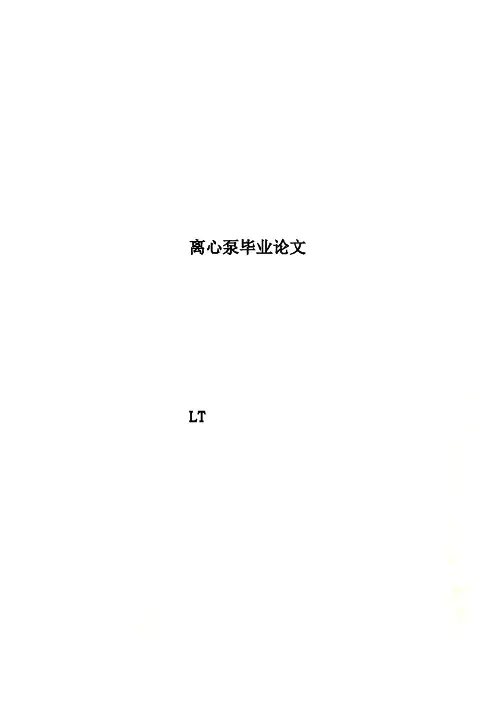
离心泵毕业论文LT第一章泵的概述1.1 离心泵的基本结构离心泵的主要零件有叶轮、泵轴、泵体(泵壳)、泵盖、密封环、填料及填料压盖、托架等。
基本部件是高速旋转的叶轮和固定的蜗牛形泵壳。
图1、1 离心泵(1)通过泵体内高速旋转的叶轮对液体做功从而实现离心泵输送液体的目的,由此可知叶轮在离心泵内的重要地位。
叶轮需在装配前进行静平衡实验,并保持其内外表面光滑以水流的摩擦损失。
叶轮按其结构形式又可分为闭式叶轮、半开式叶轮及开式叶轮,且闭式叶轮适用于输送澄清的液体,半开式叶轮适用于输送粘稠及含有固体颗粒的液体,开式叶轮则适用于输送污水、含沙及含纤维的液体。
图1、2 叶轮结构形式叶轮按其吸液方式又可分为单吸式与双吸式两种,单吸式叶轮结构简单,液体只能从一侧吸入。
双吸式叶轮可同时从叶轮两侧对称地吸入液体,它不仅具有较大的吸液能力,而且基本上消除了轴向推力。
叶轮内部叶片的弯曲方向决定了扬程的大小,故而可根据叶轮上叶片的几何形状将叶片分为前弯、后弯与径向(出口)三种,又由于后弯叶片有利于液体的动能转换为静压能,故而在国民经济生产中得到了广泛的使用。
(2)泵轴利用联轴器和电动机相连接,将电动机的转矩传递给叶轮,是传递机械能的主要部件。
(3)泵体,即泵壳,是离心泵的主体,与离心泵的安装轴承托架相连接起支撑固定作用。
(4)密封环即减漏环,由于叶轮进口与泵壳间的间隙过大会造成泵内高压区的水从间隙处流向低压区,影响泵的出水量导致离心泵的效率降低;过小则造成叶轮与泵壳摩擦产生磨损。
故而为了延长叶轮与泵壳的使用寿命,需在泵壳内缘和叶轮外缘结合处装置密封环,且密封间隙保持在0.25~1.10mm之间最为恰当。
(5)填料函主要由填料、水封环、填料筒、填料压盖及水封管组成,其主要作用是为了封闭泵壳与泵轴之间的空隙,始终保持离心泵内的真空,不让水或空气由间隙流入泵内。
当泵轴与填料摩擦产生热量时就要通过水封管向水封圈内注水从而使填料冷却下来。
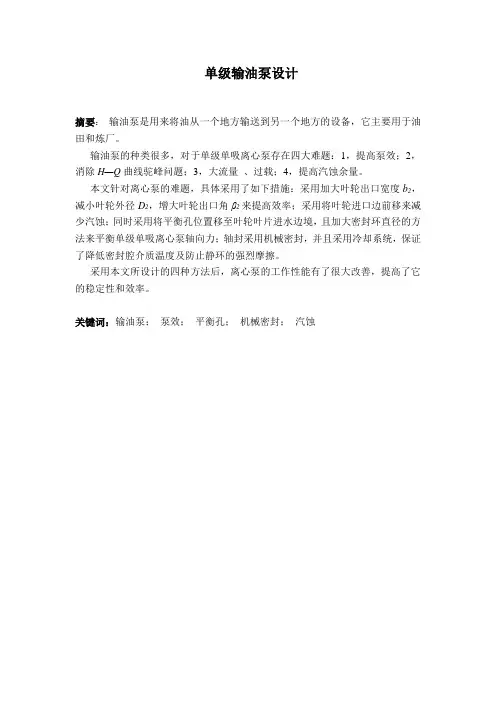
单级输油泵设计摘要:输油泵是用来将油从一个地方输送到另一个地方的设备,它主要用于油田和炼厂。
输油泵的种类很多,对于单级单吸离心泵存在四大难题:1,提高泵效;2,消除H—Q曲线驼峰问题;3,大流量、过载;4,提高汽蚀余量。
本文针对离心泵的难题,具体采用了如下措施:采用加大叶轮出口宽度b2,减小叶轮外径D2,增大叶轮出口角β2来提高效率;采用将叶轮进口边前移来减少汽蚀;同时采用将平衡孔位置移至叶轮叶片进水边境,且加大密封环直径的方法来平衡单级单吸离心泵轴向力;轴封采用机械密封,并且采用冷却系统,保证了降低密封腔介质温度及防止静环的强烈摩擦。
采用本文所设计的四种方法后,离心泵的工作性能有了很大改善,提高了它的稳定性和效率。
关键词:输油泵;泵效;平衡孔;机械密封;汽蚀The Desigin Of The Single Stage Oil Pump Abstract: The oil pump is an equipment that be used to transport the oil from one place to other.It is many used in oil field and oil refiner.The oil pumps can be divided into many types,For single-stage single-suction centrifugal pump four problems exist: 1,Improve the efficiency of the pump; 2,Elimination of H-Q curve hump problems; 3,Large flow、overload; 4,Improve the NPSH.For the problem of centrifugal pump,we specific use of the following measures in this paper:Increase the impeller outlet widthb2,reduced impeller diameter D2,increasing the impeller outlet angle β2to improve efficiency;Reduce cavitation by forward edge of the impeller inlet;At the same time, balanced single-stage single-suction centrifugal axial force by impeller balance hole location to the border water and increase the diameter of seal ringp;seal using the mechanical shaft seal,and using cooling system,Sealed chamber to ensure that the medium temperature to reduce and to prevent the stati cring’s strong friction.Designed in this paper is, after four methods, centrifugal pump performance has greatly improved,it also can improve its stability and efficiency.Key words: pump; pump efficiency; balance hole; mechanical seal; cavitation目录前言 (1)1 泵结构方案的选择 (2)1.1泵吸入口和排出口的确定 (2)1.2泵结构形式的确定 (2)1.2.1确定比转数ns: (2)1.2.2原动机的选择: (3)1.2.3确定泵的结构形式 (3)1.3最小轴颈的初步计算 (3)2 泵叶轮的设计 (5)2.1速度系数设计法 (5)2.1.1 速度系数设计法的计算步骤 (5)2.2 叶轮绘型 (9)3 压出室及吸入室的设计 (12)3.1 吸水室的结构设计 (12)3.2 压出室的结构设计 (13)3.2.1 压水室的作用和要求 (13)3.2.2 任意断面的螺旋压水室的设计 (13)4离心泵径向力、轴向力的平衡及平衡装置的设计 (19)4.1 离心泵径向力的平衡及平衡装置的设计计算 (19)4.1.1 径向力的平衡 (19)4.1.2 径向力的计算 (19)4.2 离心泵中轴向力的平衡及计算 (20)4.2.1 轴向力的计算 (20)4.2.2 轴向力的的平衡 (22)5 离心泵中主要零部件的设计 (24)5.1 轴的机构设计及校核 (24)5.1.1 轴的机构设计 (24)5.1.2 轴的校核 (25)5.2 转子临界转速的计算 (27)5.3 联轴器的选择与校核 (29)5.3.1 联轴器的选择 (29)5.3.2 联轴器的校核 (29)5.4 键的选择和校核 (30)5.4.1 键的选择 (30)5.4.2 键的校核 (30)5.5 轴承的选择及校核 (31)5.5.1 轴承的选择 (31)5.5.2 轴承的校核 (32)6 轴及叶轮密封结构的选择 (34)6.1 叶轮密封环的选择 (34)6.1.1 确定叶轮入口宽度b1 (34)6.1.2 叶片厚度 (35)6.2 轴端密封 (35)6.2.1 泵的轴封结构 (35)6.2.2 机械密封的结构、分类、工作原理及优点 (35)6.2.3 选择机械密封形式的依据 (36)6.2.4 机械密封的冷却及润滑 (37)6.2.5 抽空破坏及防抽空的方法............... 错误!未定义书签。
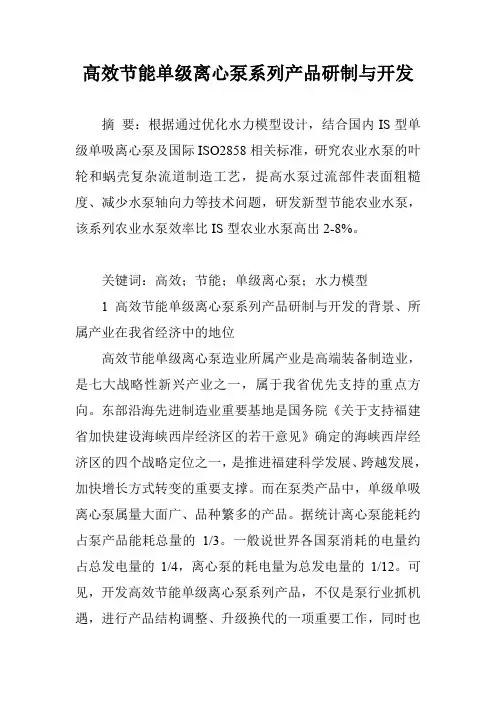
高效节能单级离心泵系列产品研制与开发摘要:根据通过优化水力模型设计,结合国内IS型单级单吸离心泵及国际ISO2858相关标准,研究农业水泵的叶轮和蜗壳复杂流道制造工艺,提高水泵过流部件表面粗糙度、减少水泵轴向力等技术问题,研发新型节能农业水泵,该系列农业水泵效率比IS型农业水泵高出2-8%。
关键词:高效;节能;单级离心泵;水力模型1 高效节能单级离心泵系列产品研制与开发的背景、所属产业在我省经济中的地位高效节能单级离心泵造业所属产业是高端装备制造业,是七大战略性新兴产业之一,属于我省优先支持的重点方向。
东部沿海先进制造业重要基地是国务院《关于支持福建省加快建设海峡西岸经济区的若干意见》确定的海峡西岸经济区的四个战略定位之一,是推进福建科学发展、跨越发展,加快增长方式转变的重要支撑。
而在泵类产品中,单级单吸离心泵属量大面广、品种繁多的产品。
据统计离心泵能耗约占泵产品能耗总量的1/3。
一般说世界各国泵消耗的电量约占总发电量的1/4,离心泵的耗电量为总发电量的1/12。
可见,开发高效节能单级离心泵系列产品,不仅是泵行业抓机遇,进行产品结构调整、升级换代的一项重要工作,同时也具有十分显著的社会与经济效益。
目前我国泵的总品种约为3000多种,而国外泵的品种在6000种以上,我国在泵的品种上仍有不少缺口,现有品种仅能基本适应国民经济发展的要求。
目前我国单级单吸单级离心泵现状及发展方向是IS型单级清水离心泵,现已占据我国单级泵主导位置30余年。
由于泵本身技术在进步,另一方面国民经济各部门对泵不断提出更多更高的要求,现有单级泵的性能难以满足国家的需要,尤其是泵的效率与现代的高效节能产品相比存在着很大的差距。
主要表现在:性能参数范围窄;效率和汽蚀指标偏低;叶轮进口堵塞,面积小,流速过高,影响汽蚀性能。
整体结构造型、零部件的结构有待改进。
据统计离心泵能耗约占泵产品能耗总量的1/3。
一般说世界各国泵消耗的电量约占总发电量的1/4,离心泵的耗电量为总发电量的1/12。

XXXXX 学院毕业设计(论文) 题目学生姓名年级专业学号指导教师起止日期20 年月日XXXXX学院毕业设计 (论文)任务书机电工程系班级()姓名学号北海职业学院学生毕业设计(论文)成绩鉴定表综述离心泵的完好标准泵与风机、压缩机是流体机械的重要组成部分,一直是制冷与空调专业人士学习的基本科目。
泵是输送液体或使液体增压的机械。
它将原动机的机械能或其他外部能量传送给液体,使液体能量增加。
泵主要用来输送液体包括水、油、酸碱液、乳化液、悬乳液和液态金属等,也可输送液体、气体混合物以及含悬浮固体物的液体。
离心泵就是根据设计高速旋转的叶轮叶片带动水转动,将水甩出,从而达到输送的目的. 离心泵有好多种.从使用上可以分为民用与工业用泵,从输送介质上可以分为清水泵、杂质泵、耐腐蚀泵等。
一离心泵的分类方式类型特点一览表二、离心泵基本构造离心泵的基本构造是由六部分组成的,分别是:叶轮,泵体,泵轴,轴承,密封环,填料函。
1、叶轮是离心泵的核心部分,它转速高输出力大,叶轮上的叶片又起到主要作用,叶轮在装配前要通过静平衡实验。
叶轮上的内外表面要求光滑,以减少水流的摩擦损失。
2、泵体也称泵壳,它是水泵的主体。
起到支撑固定作用,并与安装轴承的托架相连接。
3、泵轴的作用是借联轴器和电动机相连接,将电动机的转距传给叶轮,所以它是传递机械能的主要部件。
4、轴承是套在泵轴上支撑泵轴的构件,有滚动轴承和滑动轴承两种。
滚动轴承使用牛油作为润滑剂加油要适当一般为2/3~3/4的体积太多会发热,太少又有响声并发热!滑动轴承使用的是透明油作润滑剂的,加油到油位线。
太多油要沿泵轴渗出并且漂*,太少轴承又要过热烧坏造成事故!在水泵运行过程中轴承的温度最高在85度一般运行在60度左右,如果高了就要查找原因(是否有杂质,油质是否发黑,是否进水)并及时处理!5、密封环又称减漏环。
叶轮进口与泵壳间的间隙过大会造成泵内高压区的水经此间隙流向低压区,影响泵的出水量,效率降低!间隙过小会造成叶轮与泵壳摩擦产生磨损。

CENTRIFUGAL PUMPS IN THE CHEMICAL INDUSTRYAbstract : A centrifugal pump converts the input power to kinetic energy in the liquid by accelerating the liquid by a revolving device - an impeller. The most common type is the volute pump. Fluid enters the pump through the eye of the impeller which rotates at high speed. The fluid is accelerated radially outward from the pump chasing. A vacuum is created at the impellers eye that continuously draws more fluid into the pump . This article stresses on a series of centrifugal pumps,From a brief introduction to the principles.Keywords : centrifugal pump ,Introduction ,Working principle , Cavitation ,Mechanism of Cavitation ,Solution and Remedies1. IntroductionPump ,device used to raise ,transfer ,or compress liquids and gases .Four general classes of pumps for liquids are described below .In all of them ,steps are taken to prevent cavitation (the formation of a vacuum) ,which would reduce the flow and damage the structure of the pump .Pumps used for gases and vapors are usually known as compressors .The study of fluids in motion is called fluid dynamics.Water pump ,device for moving water from one location to another ,using tubes or other machinery .Water pumps operate under pressures ranging from a fraction of a pound to more than 10,000 pounds per square inch .Everyday examples of water pumps range from small electric pumps that circulate and aerate water in aquariums and fountains to sump pumps that remove water from beneath the foundations of homes .One type of modern pumps used to move water is the centrifugal pump .Early version of the centrifugal pump ,the screw pump ,consists of a corkscrew-shaped mechanism in a pipe that ,when rotated ,pulls water upward .Screw pumps are often used in waste-water treatment plants because they can move large amounts of water without becoming clogged with debris .In the ancient Middle East the need for irrigation of farmland was a strong inducement to develop a water pump .Early pumps in this region were simple devices for lifting buckets of water from a source to a container or a trench .Greek mathematician and inventor Archimedes is thought to have devised the first screw pump in the third century BC .Later Greek inventor Ctesibius develop the first lift pump .During the late 17th and early 18th CenturiesAD ,British engineer Thomas Savery ,French physicist Denis Papin ,And British blacksmith and inventor Thomas Newcomen contributed to the development of a water pump that used steam to power the pump’ piston .The steam-powered water pump’s first wide use was in pumping water out of mines .Modern-day examples of centrifugal pumps are those used at the Grand Coulee Dam on the Columbia River .This pump system has the potential to irrigate over one million acres of land . Also known as rotary pumps ,centrifugal pumps have a rotating impeller ,also known as a blade ,that is immersed in the liquid .Liquid enters the pump near the axis of the impeller ,and the rotating impeller sweeps the liquid out toward the ends of the impeller blades at high pressure .The impeller also gives the liquid a relatively high velocity that can be converted into pressure in a stationary part of the pump ,known as the diffuser .In high-pressure pumps ,a number of impeller may be used in series ,and the diffusers following each impeller may contain guide vanes to gradually reduce the liquid velocity .For lower-pressure pumps ,the diffuser is generally a spiral passage ,known as a volute ,with its cross-sectional area increasing gradually to reduce the velocity efficiently .The impeller must be primed before it can begin operation ,that is ,the impeller must be surrounded by liquid when the pump is started .This can be done by placing a check valve in the suction line ,which holds the liquid in the pump when the impeller is not rotating .If this valve leaks ,the pump may need to be primed by the introduction of liquid from an outside source such as the discharge reservoir .A centrifugal pump generally has a valve in the discharge line to control the flow and pressure .For low flows and high pressures ,the action of the impeller is largely radial .For higher flows and lower discharge pressure ,the direction of the flow within the pump is more nearly parallel to the axis of the shaft ,and the pump is said to have an axial flow .The impeller in this case acts as a propeller .The transition from one set of floe conditions to the other is gradual ,and for intermediate condition , the device is called a mixed-flow pump .2.The Centrifugal PumpThe centrifugal pump is by far the most widely used type in the chemical and petroleum industries .It will pump liquids with very wide ranging properties and suspensions with a high solids content including ,for example ,cement slurries ,and may be constructed from a very wide rang of corrosion resistant materials .The whole pump casing may be constructed from plastic such as polypropylene or it may be fitted with a corrosion-resistant lining .Because it operates at high speed ,it may bedirectly coupled to an electric motor and it will give a high flow rate for its size .In this type of pump ,the fluid is fed to the centre of a rotating impeller and is thrown outward by centrifugal action .As a result of the high speed of rotation the liquid acquires a high kinetic energy and the pressure difference between the suction and delivery sides arises from the conversion of kinetic energy into pressure energy . The impeller consists of a series of curved vanes so shaped that the flow within the pump is as smooth as possible .The greater the number of vanes on the impeller ,the greater is the control over the direction of the liquid and hence the smaller are the losses due to turbulence and circulation between the vanes .In the open impeller ,the vanes are fixed to a central hub ,whereas in the closed type the vanes are held between two supporting plates and leakage across the impeller is reduced .As will be seen later ,the angle of the tips of the blades very largely determines the operating characteristics of the pump .The liquid enters the casing of the pump,normally in an axial direction,and is picked up by the vanes of the impeller.In the simple type of centrifugal pump,the liquid discharges into a volute,a chamber of gradually increasing cross—section with a tangential outlet.A volute type of pump is shown in Fig.(a).In the turbine pump[-Fig.(b)]the liquid flows from the moving vanes of the impeller through a series of fixed vanes forming a diffusion ring.This gives a more gradual change in direction to the fluid and more efficient conversion of kinetic energy into pressure energy than is obtained with the volute type.The angle of the leading edge of the fixed vanes should be such that the fluid is received without shock.The liquids flows along the surface of the impeller vane with a certain velocity whilst the tip of the vane is moving relative to the casing of the pump.The direction of motion of the liquid relative to the pump casing--and the required angle of the fixed vanes—is found by compounding these two velocities.In Fig.c,c.v u is the velocity of the liquid relative to the vane and t u is the tangential velocity of the tip of the vane ;compounding these two velocities gives the resultant velocity 2u of the liquid .It is apparent ,therefore ,that the required vane angle in the diffuser is dependent on the throughput ,the speed of rotation ,and the angle of the impeller blades .The pump will therefore operate at maximum efficiency only over a narrow range of conditions .Virtual head of a centrifugal pumpThe maximum pressure is developed when the whole of the excess kinetic energy of the fluid is converted into pressure energy. As indicated below .the head is proportional to the square of the radius and to the speed ,and is of the order of 60m for a single —stage centrifugal pump ;for higher pressures ,multistage pumps must be used .Consider the liquid which is rotating at a distance of between r and r+dr from the centre of the pump(Fig .d).dThe mass of this element of fluid dm is given by 2πrdrdρ,where ρ is the density of the fluid and 6 is the width of the element of fluid 。
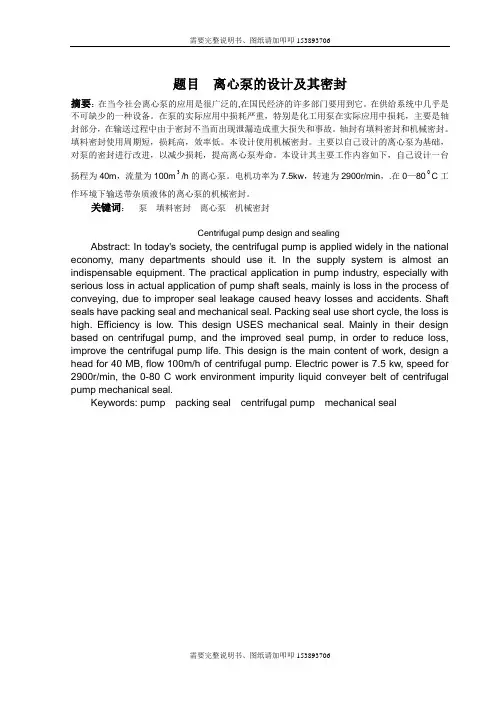
题目离心泵的设计及其密封摘要:在当今社会离心泵的应用是很广泛的,在国民经济的许多部门要用到它。
在供给系统中几乎是不可缺少的一种设备。
在泵的实际应用中损耗严重,特别是化工用泵在实际应用中损耗,主要是轴封部分,在输送过程中由于密封不当而出现泄漏造成重大损失和事故。
轴封有填料密封和机械密封。
填料密封使用周期短,损耗高,效率低。
本设计使用机械密封。
主要以自己设计的离心泵为基础,对泵的密封进行改进,以减少损耗,提高离心泵寿命。
本设计其主要工作内容如下,自己设计一台扬程为40m,流量为100m3/h的离心泵。
电机功率为7.5kw,转速为2900r/min,.在0—800C工作环境下输送带杂质液体的离心泵的机械密封。
关键词:泵填料密封离心泵机械密封Centrifugal pump design and sealingAbstract: In today's society, the centrifugal pump is applied widely in the national economy, many departments should use it. In the supply system is almost an indispensable equipment. The practical application in pump industry, especially with serious loss in actual application of pump shaft seals, mainly is loss in the process of conveying, due to improper seal leakage caused heavy losses and accidents. Shaft seals have packing seal and mechanical seal. Packing seal use short cycle, the loss is high. Efficiency is low. This design USES mechanical seal. Mainly in their design based on centrifugal pump, and the improved seal pump, in order to reduce loss, improve the centrifugal pump life. This design is the main content of work, design a head for 40 MB, flow 100m/h of centrifugal pump. Electric power is 7.5 kw, speed for 2900r/min, the 0-80 C work environment impurity liquid conveyer belt of centrifugal pump mechanical seal.Keywords: pump packing seal centrifugal pump mechanical seal二离心泵的工作原理以及方案选择2.1 离心泵的工作原理离心泵工作前,先将泵内充满液体,然后启动离心泵,叶轮快速转动,叶轮的叶片驱使液体转动,液体转动时依靠惯性向叶轮外缘流去,同时叶轮从吸入室吸进液体,在这一过程中,叶轮中的液体绕流叶片,在绕流运动中液体作用一升力于叶片,反过来叶片以一个与此升力大小相等、方向相反的力作用于液体,这个力对液体做功,使液体得到能量而流出叶轮,这时候液体的动能与压能均增大。
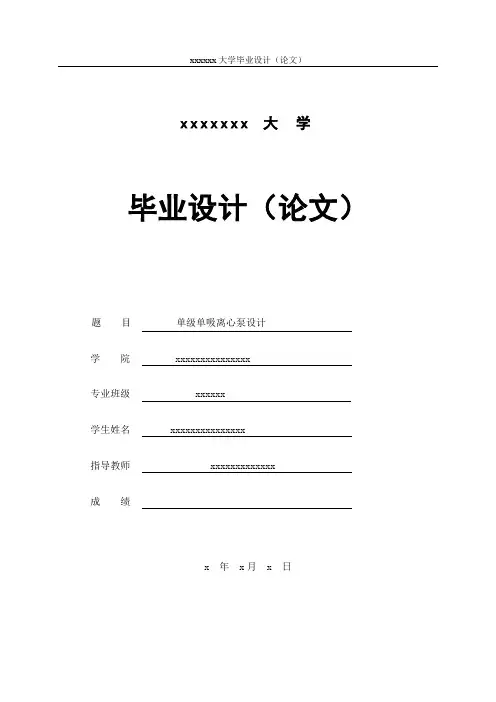
x x x x x x x大学毕业设计(论文)题目单级单吸离心泵设计学院 xxxxxxxxxxxxxxx专业班级 xxxxxx学生姓名 xxxxxxxxxxxxxxx指导教师 xxxxxxxxxxxxx成绩x 年x月x 日摘要离心泵是一种用量最大的水泵,在给水排水及农业工程、固体颗粒液体输送工程、石油及化学工业、航空航天和航海工程、能源工程和车辆工程等国民经济各个部门都有广泛的应用。
在此设计中,主要包括单级单吸清水离心泵的方案设计,离心泵基本参数选择、离心泵叶片的水力设计、离心泵压水室的水利设计、离心泵吸水室的水利设计。
以及进行轴向力及径向力的平衡,最后要进行强度校核。
泵设计的最大难点就是泵的密封,本次设计采用的新式的填料密封,它可以根据压力的改变来改变密封力的装置。
关键词:离心泵;叶片;压水室;吸水室AbstractCentrifugal pump is a kind of the most consumable in pumps, water drainage and in agricultural engineering, solid particles liquid transportation engineering, oil and chemical industry, aerospace and Marine engineering, energy engineering and vehicle engineering, etc all departments of national economy is widely used.In this design, including single-stage single-suction clean water centrifugal pump design, the basic parameters centrifugal pump, centrifugal pump hydraulic design of leaves, water pump pressurized water chamber design, the water pump suction chamber design. As well as axial force and radial force balance, and finally to the strength check.The biggest difficulty pump design is the design of the pump seal, the new packing seal it can according to the change of the pressure to change the device sealing force.Keywords:Centrifugal pump;Leaves; Pressurized water chamber; Suction chamber目录摘要.............................................................................................................................................. Abtract (II)第1章绪论 01.1 选此课题的意义 01.2 本课题的研究现状 01.3 本课题研究的主要内容 0第2章泵的基本知识 (2)2.1 泵的功能 (2)2.2 泵的概述 (2)2.2.1 离心泵的主要部件 (2)2.2.2 离心泵的工作原理 (3)2.3 泵的分类 (3)第3章离心泵的水力设计 (4)3.1 泵的基本设计参数 (4)3.2 泵的比转速计算 (4)3.3 泵进口及出口直径的计算 (4)3.4 计算空化比转速 (4)3.5 泵的效率计算 (5)3.5.1 水力效率 (5)3.5.2 容积效率 (5)3.5.3 机械效率 (5)3.5.4 离心泵的总效率 (5)3.6 轴功率的计算和原动机的选择 (5)3.6.1 计算轴功率 (5)3.6.2 确定泵的计算功率 (6)3.6.3 原动机的选择 (6)3.7 轴径与轮毂直径的初步计算 (6)3.7.1 轴的最小直径 (6)3.7.2 轮毂直径的计算 (7)3.8 泵的结构型式的选择 (8)第4章叶轮的水力设计 (9)4.1 确定叶轮进口速度 (9)4.2 计算叶轮进口直径 (9)4.2.1 先求叶轮进口的有效直径D0 (9)4.2.2 叶轮进口直径 (10)4.3 确定叶轮出口直径 (10)4.4 确定叶片厚度 (10)4.5 叶片出口角的确定 (11)4.6 叶片数Z的选择与叶片包角 (11)4.7 叶轮出口宽度 (11)4.8 叶轮出口直径及叶片出口安放角的精确计算 (12)4.9 叶轮轴面投影图的绘制 (12)4.10 叶片绘型 (13)第5章压水室的水力设计 (16)5.1 压水室的作用 (16)5.2 蜗型体的计算 (16)5.2.1 基圆直径的确定 (16)5.2.2 蜗型体进口宽度计算 (17)5.2.3 舌角 (17)5.2.4 隔舌起始角 (17)5.2.5 蜗形体各断面面积的计算 (17)5.2.6 扩散管的计算 (18)5.2.7 蜗形体的绘型 (18)第6章吸水室的设计 (20)6.1 吸水室尺寸确定 (20)第7章径向力轴向力及其平衡 (21)7.1 径向力及平衡 (21)7.1.1 径向力的产生 (21)7.1.2 径向力的计算 (21)7.1.3 径向力的平衡 (21)7.2 轴向力及平衡 (22)7.2.1 轴向力的产生 (22)7.2.2 轴向力计算 (22)7.2.3 轴向力的平衡 (23)第8章泵零件选择及强度计算 (24)8.1 叶轮盖板的强度计算 (24)8.2 叶轮轮毂的强度计算 (24)8.3 叶轮配合的选择 (25)8.4 轮毂热装温度计算 (26)8.5 轴的强度校核 (26)8.6 键的强度计算 (28)8.6.1 工作面上的挤压应力 (28)8.6.2 切应力 (29)8.7 轴承和联轴器的选择 (29)第9章泵体的厚度计算 (31)9.1 蜗壳厚度的计算 (31)9.2 中段壁厚的计算 (31)第10章泵的轴封 (32)10.1 常用的轴封种类及设计要求 (32)10.2 填料密封的工作原理 (32)10.3 传统填料密封结构及其缺陷 (33)10.3.1 传统填料密封结构 (33)10.3.2 传统填料密封的不足 (33)10.4 填料密封的结构改造 (33)结论 (34)参考文献 (36)致谢 (38)第1章绪论1.1 选此课题的意义泵是一种应用广泛、耗能大的通用流体机械,我国每年各种泵的耗电量大约占全国总耗电量的20%,耗油量大约占全国总耗油量的50%。
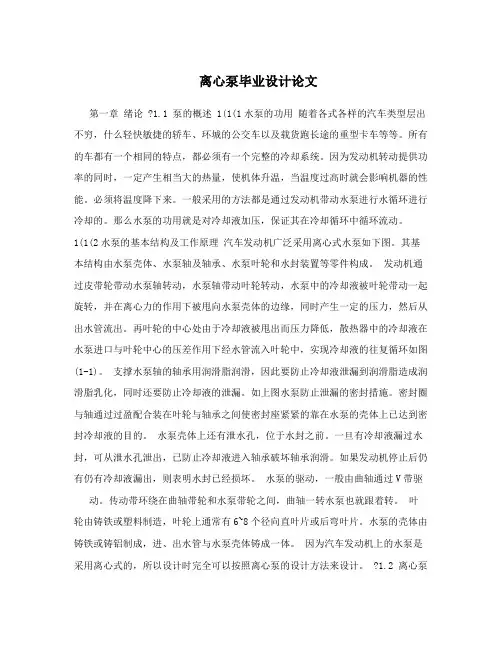
离心泵毕业设计论文第一章绪论 ?1.1 泵的概述 1(1(1水泵的功用随着各式各样的汽车类型层出不穷,什么轻快敏捷的轿车、环城的公交车以及载货跑长途的重型卡车等等。
所有的车都有一个相同的特点,都必须有一个完整的冷却系统。
因为发动机转动提供功率的同时,一定产生相当大的热量,使机体升温,当温度过高时就会影响机器的性能。
必须将温度降下来。
一般采用的方法都是通过发动机带动水泵进行水循环进行冷却的。
那么水泵的功用就是对冷却液加压,保证其在冷却循环中循环流动。
1(1(2水泵的基本结构及工作原理汽车发动机广泛采用离心式水泵如下图。
其基本结构由水泵壳体、水泵轴及轴承、水泵叶轮和水封装置等零件构成。
发动机通过皮带轮带动水泵轴转动,水泵轴带动叶轮转动,水泵中的冷却液被叶轮带动一起旋转,并在离心力的作用下被甩向水泵壳体的边缘,同时产生一定的压力,然后从出水管流出。
再叶轮的中心处由于冷却液被甩出而压力降低,散热器中的冷却液在水泵进口与叶轮中心的压差作用下经水管流入叶轮中,实现冷却液的往复循环如图(1-1)。
支撑水泵轴的轴承用润滑脂润滑,因此要防止冷却液泄漏到润滑脂造成润滑脂乳化,同时还要防止冷却液的泄漏。
如上图水泵防止泄漏的密封措施。
密封圈与轴通过过盈配合装在叶轮与轴承之间使密封座紧紧的靠在水泵的壳体上已达到密封冷却液的目的。
水泵壳体上还有泄水孔,位于水封之前。
一旦有冷却液漏过水封,可从泄水孔泄出,已防止冷却液进入轴承破坏轴承润滑。
如果发动机停止后仍有仍有冷却液漏出,则表明水封已经损坏。
水泵的驱动,一般由曲轴通过V带驱动。
传动带环绕在曲轴带轮和水泵带轮之间,曲轴一转水泵也就跟着转。
叶轮由铸铁或塑料制造,叶轮上通常有6~8个径向直叶片或后弯叶片。
水泵的壳体由铸铁或铸铝制成,进、出水管与水泵壳体铸成一体。
因为汽车发动机上的水泵是采用离心式的,所以设计时完全可以按照离心泵的设计方法来设计。
?1.2 离心泵的基本理论知识离心泵依靠旋转叶轮对液体的作用把原动机的机械能传递给液体。
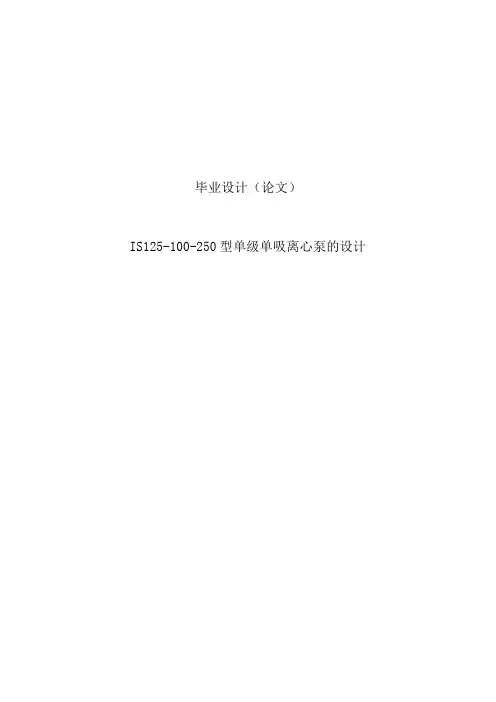
毕业设计(论文)IS125-100-250型单级单吸离心泵的设计目录摘要 (4)1前言 (5)1.1毕业设计的目的和意义 (6)1.2设计的主要任务 (6)2叶轮的设计 (6)2.1叶轮主要参数的确定和结构方案的确定 (6)2.1.1确定泵进出口直径 (7)2.1.2汽蚀计算 (7)2.1.3比转速的计算 (8)2.1.4确定效率 (8)2.1.5确定功率 (9)2.1.6初步确定叶轮的主要尺寸 (9)2.1.7精算叶轮外径 (11)2.2叶轮轴面投影图绘制中的相关计算 (13)2.2.1叶轮出口速度 (13)2.2.2流道中线检查 (13)2.2.3中间流线的划分 (14)2.2.4叶片进口边的确定 (15)2.2.5叶轮进口速度 (16)2.2.6编程计算A、B、C三点的叶片安放角 (19)2.3叶片绘型 (20)2.3.1绘型原理 (20)2.3.2绘型步骤 (21)2.3.3绘制叶片进出口三角形 (23)3汽蚀验算 (24)3.1计算清水中的必需汽蚀余量 (24)4压水室的计算及绘型 (25)4.1涡室的主要结构参数 (25)4.2涡室绘型步骤 (27)5离心泵结构设计及部分零件的强度校核 (28)5.1离心泵结构特点 (28)5.1.1叶轮 (29)5.1.2泵体 (29)5.1.3泵轴 (29)5.1.4轴承 (29)5.1.5密封环 (29)5.1.6填料函 (29)5.2部分零件的强度计算与校核 (30)5.2.1最小轴径的计算 (30)5.2.2键的计算及强度校核 (30)5.2.3轴向力的计算 (31)5.2.5轴承寿命的计算 (33)5.2.6填料的计算 (34)结论 (35)总结与体会 (36)谢辞 (36)参考文献 (36)摘要本次设计是进行IS125-100-250型单级单吸离心泵的设计,根据给定的主要设计参数,主要完成了叶轮、泵壳的水力设计,以及泵的总体结构设计,并验算泵的抗汽蚀性能,绘制泵的总装图及叶轮、泵壳、泵轴等零件图,对叶轮、泵体、泵轴、轴承、键、法兰盘和联结螺栓等泵的主要零部件进行强度校核。
单级离心泵设计论文一、设计原理1.吸入阶段:液体通过泵入口进入叶轮,当叶轮旋转时,由于离心力的作用,液体被迅速吸入叶轮。
2.压缩阶段:随着叶轮的旋转,液体被推向叶轮的外周,并且由于叶轮的形状,液体被压缩。
3.推出阶段:压缩后的液体被推向出口,形成高压液流,输送到下游设备或系统。
二、设计流程1.确定设计参数:包括流量Q、扬程H、泵入口和泵出口的直径、液体密度等参数。
2.选择泵类型:根据工况要求选择合适的泵类型,包括液体输送性质、工作温度、流量范围等。
3.计算叶轮直径:根据流量和扬程计算叶轮直径,通常采用经验公式或图表进行计算。
4.叶轮叶片数目和形状设计:根据流量和叶轮直径确定叶片数目和形状,通常采用流体力学原理进行设计。
5.确定泵的速度:根据叶轮直径和转速计算泵的速度,确保泵能够满足工作要求。
6.计算泵的效率:根据设计参数计算泵的效率,评估泵的性能。
7.进行强度计算:根据泵的工作条件和叶轮的材料选择,进行强度计算,确保泵的安全可靠性。
8.绘制泵的结构图:根据设计参数和计算结果,绘制泵的结构图。
三、设计要点在单级离心泵的设计过程中,需要注意以下几个要点:1.叶轮叶片的设计应遵循流体力学原理,确保叶轮能够有效地将流体吸入和推出。
2.泵选型应根据具体工况要求进行,包括液体输送性质、工作温度、流量范围等。
3.泵的结构设计应合理,保证泵的强度和刚度满足工作条件要求。
4.泵的效率应达到设计要求,尽量提高泵的效率,减少能源消耗。
5.泵的尺寸和材料的选择应根据具体工况进行,确保泵可以承受工作条件下的压力和温度。
综上所述,单级离心泵的设计是一个综合工程,需要考虑多个因素,包括流体力学、结构强度、泵选型等。
通过合理的设计流程和严格的设计要点,可以设计出性能优良、安全可靠的单级离心泵。
离心泵设计毕业设计论文i目录第一章离心泵的概论 (1)1. 1 离心泵的基本构造 (1)1. 2 离心泵的过流部件 (2)1. 3 离心泵的工作原理 (2)1. 4 离心泵的性能曲线 (3)第二章离心泵的应用 (5)2. 1 离心泵在工业工程的应用 (5)2. 2 离心泵在给水排水及农业工程中用 (6) 2. 3 离心泵在航空航天和航海工程中的应用 (7) 2. 4 离心泵在能源工程中的应用 (9)第三章离心泵的拆装 (11)3. 1 离心泵的结构图 (11)3. 2 离心泵一般拆卸步骤 (11)3. 3 离心泵的拆卸顺序 (11)3. 4 离心泵拆卸注意的事项 (12)3. 5 离心泵的装配 (12)第四章常见故障原因分析及处理 (13)4. 1 离心泵启动负荷 (13)4.2 泵不排液 (13)4.3 泵排液后中断 (13)4. 4 流量不足 (13)4. 5 扬程不够 (13)4. 6 运行中功耗大 (14)4. 7 泵振动或异常声响 (14)4. 8 轴承发热 (14)4. 9 轴封发热 (15)4. 10 转子窜动大 (15)4. 11 发生水击 (15)4. 12 机械密封的损坏 (15)4. 13 故障预防措施 (18)小结 (19)致谢 (20)参考文献 (21)第五章英文翻译 (22)ii1第一章离心泵概论1.1离心泵的基本构造离心泵的基本构造是由六部分组成的分别是叶轮,泵体,泵轴,轴承,密封环,填料函。
图1.1 离心泵(1)叶轮是离心泵的核心部分,它转速高出力大,叶轮上的叶片又起到主要作用,叶轮在装配前要通过静平衡实验。
叶轮上的内外表面要求光滑,以减少水流的摩擦损失。
(2)泵体也称泵壳,它是水泵的主体。
起到支撑固定作用,并与安装轴承的托架相连接。
(3)泵轴的作用是借联轴器和电动机相连接,将电动机的转距传给叶轮,所以它是传递机械能的主要部件。
(4)轴承是套在泵轴上支撑泵轴的构件,有滚动轴承和滑动轴承两种。
离心泵论文
离心泵是一种常见的液体输送设备,广泛应用于水利、城建、农田灌溉、化工、石油、制浆等行业。
离心泵的主要工作原理是利用离心力将液体从进口处吸入,然后通过旋转叶轮的运动,增加液体的动能并将其压送到出口处。
离心泵的性能与设计参数有密切关系,如泵的流量、扬程、效率等。
经过改进和优化,离心泵的性能在一定程度上得到了提高。
然而,在实际应用中,离心泵仍然存在一些问题,如性能不稳定、叶轮损坏、泄漏等。
为了解决这些问题,许多学者和工程师进行了大量的研究。
例如,他们提出了一种新型的离心泵叶轮材料,通过改变叶片形状和材料性能,提高离心泵的耐磨性和耐腐蚀性。
他们还研究了离心泵的内部流场分布,以了解流体在离心泵内的流动特性,并通过改变泵的结构或控制装置来改善离心泵的性能。
此外,一些学者还研究了离心泵的振动特性,通过分析振动信号来判断离心泵的运行状态,并预测可能出现的故障。
他们还提出了一种自适应控制方法,以提高离心泵的性能和稳定性。
总的来说,离心泵论文涵盖了离心泵的设计、优化、性能分析、振动特性、故障诊断等多个方面。
这些研究对于提高离心泵的性能和可靠性具有重要意义,并为离心泵的应用提供了理论依据和技术支持。